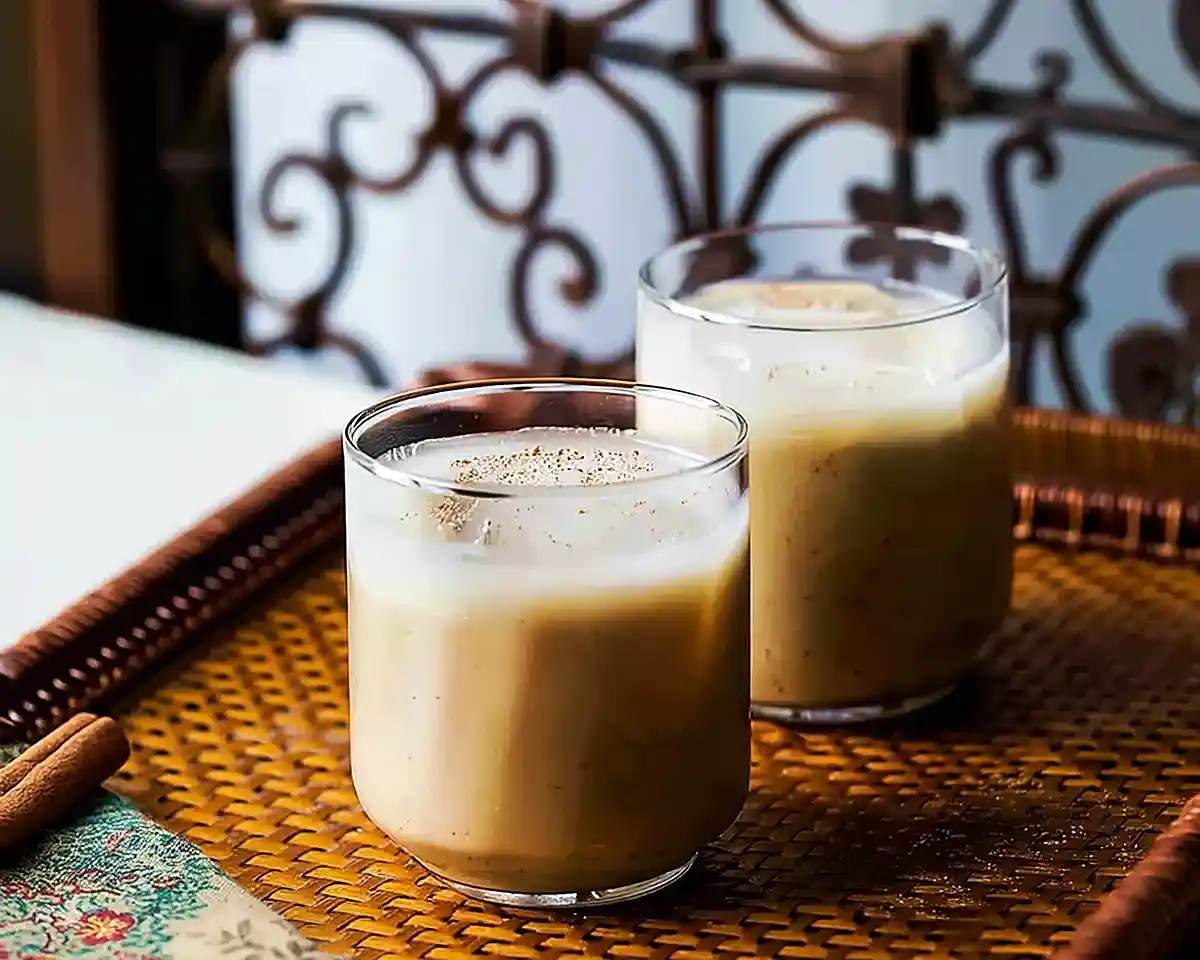Learn this authentic coquito recipe with cream of coconut and rum. This Puerto Rican coconut eggnog is creamy, spiced, and absolutely irresistible for holidays.
Last December, my neighbor Rosa handed me a bottle of homemade coquito. I took one sip and my world changed forever.
That first taste was like velvet wrapped in coconut clouds with a warm cinnamon hug. Man, oh man, I’d been missing out on this Puerto Rican treasure my whole life.
I begged Rosa for her recipe, spent three weekends testing different spice ratios, and even burned one batch (yes, you can burn coquito if you’re not careful). Now I make it every holiday season, and honestly? I sneak it into random Tuesday nights too.
This isn’t just eggnog’s tropical cousin. This is Puerto Rican tradition in a glass—rich, creamy, and spiced with just enough cinnamon to make you smile. Let me tell you, once you try homemade coquito, store-bought holiday drinks will never compare.
Table of Contents
What Makes This Coquito Recipe Special
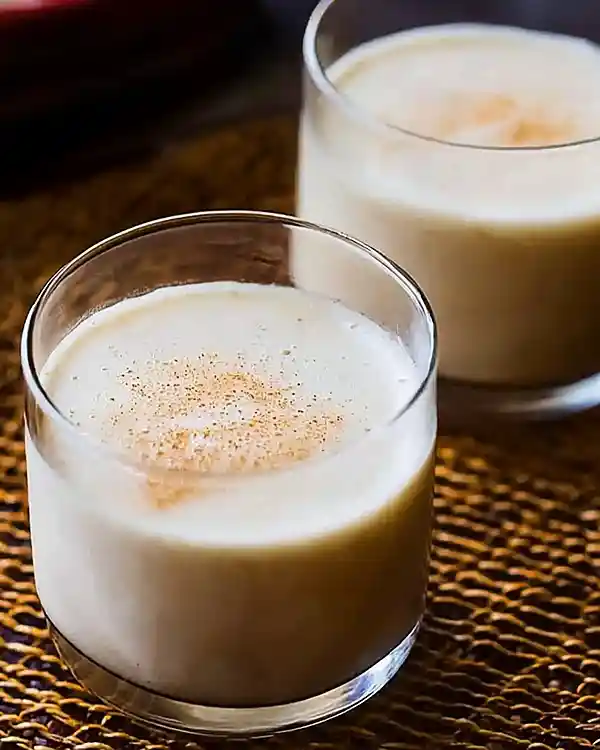
This authentic Puerto Rican coquito combines five different dairy and coconut elements for unmatched creaminess. Unlike traditional eggnog, coquito contains no eggs, making it naturally smoother and easier to prepare.
The secret lies in steeping whole spices directly in the coconut mixture. This technique, borrowed from Puerto Rican abuelas across the island, creates depth that pre-ground spices simply cannot match.
I’ve tested this recipe with multiple spice ratios and steeping times. The version you’re getting delivers the perfect balance of sweetness, coconut richness, and warming spice that characterizes authentic coquito.

Coquito: Puerto Rican Coconut Eggnog
Equipment
- Large saucepan
- wooden spoon
- Fine-mesh strainer
- Blender
- glass bottles
Ingredients
Coquito Ingredients
- 14 oz can sweetened condensed milk one standard can
- 15 oz can cream of coconut Coco Lopez or Goya
- 12 oz can evaporated milk full-fat only
- 13.5 oz can coconut milk full-fat
- 2 tsp vanilla extract
- 2 whole cinnamon sticks
- ½ tsp fresh nutmeg grated
Instructions
- Combine sweetened condensed milk, cream of coconut, evaporated milk, coconut milk, vanilla, cinnamon sticks, and nutmeg in a large saucepan. Warm over medium-high heat until gentle bubbles form at the edges, stirring occasionally.
- Remove from heat, cover, and steep for 30 minutes to infuse the spices.
- Remove the cinnamon sticks and vanilla bean if used. Strain if desired, then pour into a large pitcher. Add rum extract if making an alcohol-free version.
- Refrigerate for at least 2 hours to chill thoroughly.
- Shake well before serving. Pour into small glasses and garnish with grated nutmeg.
Notes
Ingredient Categories and Quality Tips
For best results, select cream of coconut with minimal stabilizers—Coco Lopez and Goya remain the gold standards. Choose full-fat coconut milk for maximum richness, and opt for whole cinnamon sticks over ground cinnamon.
Fresh nutmeg makes an enormous difference here. If you’ve only used pre-ground nutmeg, prepare for a revelation when you grate it fresh.
Coquito Ingredients Table
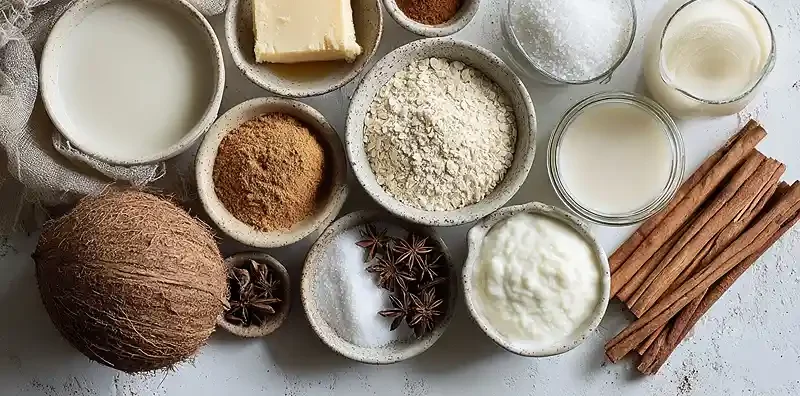
| Ingredient | US Measurement | Metric | Notes |
|---|---|---|---|
| Sweetened condensed milk | 14 oz can | 397g | One standard can |
| Cream of coconut | 15 oz can | 425g | Coco Lopez or Goya brand |
| Evaporated milk | 12 oz can | 354ml | Full-fat only |
| Coconut milk | 13.5 oz can | 400ml | Full-fat, not light |
| Vanilla extract | 2 tsp | 10ml | Or 1 vanilla bean |
| Cinnamon sticks | 2 whole | 2 whole | Ceylon or Cassia |
| Fresh nutmeg | 1/2 tsp grated | 1g | Plus extra for garnish |
Shopping Tips for US Grocery Stores
Find cream of coconut in the cocktail mixer aisle, not with regular coconut milk. Most major chains stock Coco Lopez near margarita mixes and simple syrups.
Evaporated milk sits with baking supplies, usually near sweetened condensed milk. Don’t confuse the two—they’re completely different products with distinct roles in this recipe.
Full-fat coconut milk typically lives in the international foods aisle. Look for brands like Thai Kitchen or Chaokoh for the richest texture in your homemade coquito.
Coquito Recipe Essential Ingredients
Dairy and Coconut Base: The combination of four different coconut and milk products creates coquito’s signature texture. Sweetened condensed milk adds sweetness and body, while evaporated milk prevents the drink from becoming too thick.
Spices: Whole cinnamon sticks and fresh grated nutmeg are non-negotiable for authentic flavor. Ground spices make the drink gritty and lack the aromatic complexity that steeping provides.
Vanilla: Pure vanilla extract delivers the best flavor, though a split vanilla bean creates an even more luxurious taste. The vanilla bean also looks stunning during the steeping process.
Bold Add-Ins and Creative Variations
Chocolate Coquito: Add 1/4 cup cocoa powder or 2 ounces melted dark chocolate to the warm mixture before steeping. This variation has become mainstream in recent years and tastes like a coconut-spiked hot chocolate.
Pistachio Coquito: Blend 1/2 cup shelled pistachios with the final mixture for a nutty twist. Strain before serving for silky texture.
Coffee Coquito: Stir in 2 tablespoons instant espresso powder during the steeping phase for a surprising grown-up flavor.
Substitutions for Dietary Needs
For an alcohol-free version that maintains traditional flavor, add 1-2 teaspoons of rum extract to the final mixture. This provides the characteristic taste without any alcohol content.
Lactose-intolerant guests can enjoy coquito made entirely with coconut products. Replace evaporated milk with additional coconut milk and use coconut condensed milk (available at international markets).
For lower-sugar versions, reduce sweetened condensed milk to half a can and add coconut cream to maintain body. Keep in mind this significantly changes the traditional flavor profile.
Equipment and Preparation Steps
Necessary Equipment
You’ll need a large saucepan (at least 3-quart capacity), a wooden spoon for stirring, and a fine-mesh strainer if you want ultra-smooth coquito. A blender helps if you’re adding chocolate or nuts, but it’s optional for the classic recipe.
Glass bottles make gorgeous gift containers for homemade coquito. I save old wine bottles throughout the year, sterilize them, and fill them with coquito for neighbor gifts.
No punch bowl? A large pitcher works perfectly for serving. You can even use a cleaned-out coconut as a serving vessel for dramatic presentation at parties.
Step 1: Combine and Warm the Base Ingredients
Pour sweetened condensed milk, cream of coconut, evaporated milk, and coconut milk into your large saucepan. Add vanilla extract (or split vanilla bean), whole cinnamon sticks, and grated nutmeg.
Place the pan over medium-high heat and stir occasionally to prevent scorching. Watch carefully as the mixture approaches a simmer—you want gentle bubbles around the edges, not a rolling boil.
Oops! I once walked away during this step and came back to find a burnt coconut mess stuck to my pan. Stay present and stir every minute or so.
Step 2: Steep the Spices for Maximum Flavor
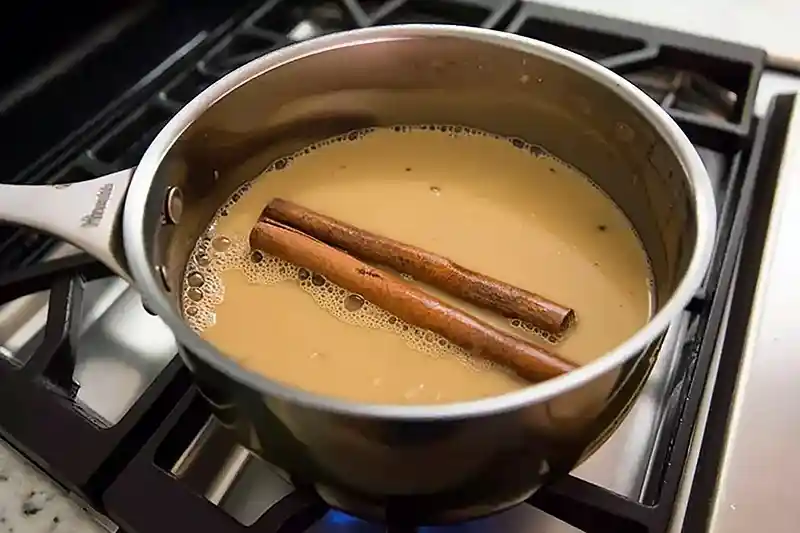
Remove the pan from heat the moment you see those first gentle bubbles. Cover immediately with a tight-fitting lid to trap all the aromatic steam inside.
Let this mixture infuse for exactly 30 minutes. This steeping technique, similar to how Thomas Keller builds flavor in his sauces, allows the cinnamon and nutmeg to fully bloom without becoming bitter.
Set a timer so you don’t forget. I usually prep my bottles and clean the kitchen during this half hour.
Step 3: Strain and Finish the Mixture
Fish out the cinnamon sticks and vanilla bean with tongs or a slotted spoon. I rinse these off, dry them completely, and save them in my spice drawer for future rice pudding or oatmeal—nothing goes to waste.
Pour the warm mixture into a large pitcher or punch bowl. If you’re adding rum extract for flavor without alcohol, stir it in now while the mixture is still slightly warm.
Give everything a good stir to ensure the flavors are evenly distributed throughout. The mixture should be smooth, creamy, and fragrant with cinnamon and vanilla.
Step 4: Chill Thoroughly Before Serving
Transfer your coquito to glass bottles or a sealed container and refrigerate for at least 2 hours. The flavors marry and mellow during this chilling period, creating that smooth, velvety texture coquito is famous for.
Well… I know waiting feels impossible, but trust me on this one. Cold coquito tastes dramatically better than room-temperature coquito.
You can prepare this up to 5 days ahead, making it perfect for stress-free holiday entertaining. The flavors actually improve after 24 hours in the refrigerator.
Step 5: Serve with Style
Pour chilled coquito into small glasses—this drink is rich, so 3-4 ounce servings are plenty. Serve it neat in small cups for authenticity, or over ice if your guests prefer.
Grate fresh nutmeg over each glass right before serving. You could also dust with ground cinnamon for a beautiful presentation.
Shake or stir the coquito before each pour, as natural separation occurs during storage. This is completely normal and actually indicates you’re using quality ingredients without artificial stabilizers.
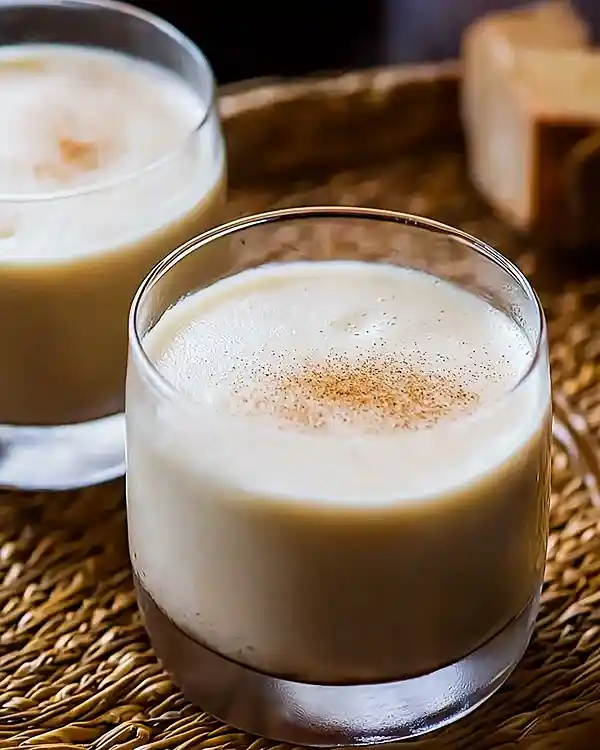
Expert Tips for the Best Homemade Coquito
Getting the Perfect Consistency
Coquito should coat the back of a spoon but still pour easily. If yours is too thick after chilling, thin it with coconut milk one tablespoon at a time.
For ultra-smooth texture, blend the entire mixture for 30 seconds after removing the whole spices. This creates an almost ice-cream-like consistency many people prefer.
You know what works great? Letting the mixture come to room temperature for 10 minutes before blending. This prevents your blender from struggling with cold, thick liquid.
Texture Troubleshooting
If your coquito separates in the bottle, shake vigorously before serving. Some separation is normal and doesn’t affect flavor or safety—it’s simply the coconut cream rising to the top.
Never use light coconut milk thinking it will save calories. The fat content in full-fat coconut milk is essential for creating coquito’s signature silky texture.
Sweetened condensed milk can sometimes crystallize in cold temperatures. If you notice graininess, let the coquito sit at room temperature for 15 minutes, then shake well.
Make-Ahead and Storage Wisdom
Properly stored coquito lasts up to 5 days in the refrigerator without alcohol. Always keep it in sealed glass containers to prevent it from absorbing other refrigerator odors.
The flavor peaks between days 1 and 3, so making it the day before serving is actually ideal. Tuesday batches taste exceptional by Thursday gatherings.
Can you freeze coquito? Technically yes, but the texture changes upon thawing. If you must freeze it, blend it again after defrosting to restore smoothness.
Storage and Serving Guidelines
| Storage Method | Duration | Best Practices |
|---|---|---|
| Refrigerated | Up to 5 days | Sealed glass bottles |
| Room temperature | Not recommended | Dairy requires refrigeration |
| Frozen | Up to 2 months | Blend after thawing |
| Opened bottles | 3 days refrigerated | Shake before each pour |
Creative Variations and Serving Suggestions
Regional Puerto Rican Variations
Some families add a whole egg yolk to their coquito for extra richness. If you try this, temper the yolk carefully into the warm mixture to avoid scrambling.
Coastal regions sometimes add an extra can of coconut milk for lighter texture. This creates a more drinkable version that works beautifully for larger gatherings.
Mountain communities occasionally add a pinch of ground cloves alongside the cinnamon and nutmeg. Use sparingly—cloves can quickly overpower the drink’s delicate balance.
Holiday and Seasonal Adaptations
Christmas Coquito: Top each glass with a small candy cane for stirring. The peppermint adds a surprising coolness that complements the warm spices beautifully during December celebrations.
Three Kings Day Special: Float a gold-dusted cinnamon stick in each serving glass on January 6th for an elegant presentation that honors Puerto Rican tradition.
Summer Coquito: Freeze coquito in popsicle molds for a frozen treat. These sell out at every cookout I bring them to.
Perfect Pairings and Complementary Dishes
Pair with breakfast sausage casserole for a unique holiday brunch combination. The sweet coquito cuts through the savory richness of breakfast meats surprisingly well.
Try coquito with crack breakfast casserole for Christmas morning—your family will request this pairing every year.
Make It Your Own
Add a tablespoon of dulce de leche for caramel notes that transform this into dessert in a glass. Stir it in after removing from heat for the smoothest integration.
Rim glasses with cinnamon sugar for a festive presentation at holiday parties. Mix equal parts granulated sugar and ground cinnamon, moisten glass rims with lime juice, then dip.
Float a scoop of vanilla ice cream in each serving for a coquito float that adults and kids both adore. This technique appears in several innovative dessert recipes across Caribbean cuisines.
Homemade Coquito FAQs
What are the ingredients for coquito?
What are the ingredients for coquito? Traditional coquito requires sweetened condensed milk, cream of coconut, evaporated milk, coconut milk, vanilla, cinnamon sticks, and nutmeg. These seven core ingredients create the creamy, spiced Puerto Rican coconut eggnog that families treasure during holidays and special celebrations.
What is the best way to store homemade coquito?
What is the best way to store homemade coquito? Store coquito in sealed glass bottles in the refrigerator for up to 5 days. Shake well before each serving as natural separation occurs, and always use clean utensils when pouring to maintain freshness throughout the storage period.
Can you make coquito without alcohol?
Can you make coquito without alcohol? Absolutely—this Puerto Rican coconut eggnog is naturally alcohol-free and family-friendly. For traditional flavor depth, add 1-2 teaspoons of rum extract, though the drink remains delicious with just the vanilla, cinnamon, and nutmeg spices.
What are some common coquito mistakes?
What are some common coquito mistakes? The biggest error is boiling instead of gently simmering, which causes the dairy to curdle and creates grainy texture. Other mistakes include using pre-ground spices, storing coquito in plastic containers that absorb flavors, and serving it too warm instead of properly chilled.
Final Thoughts on This Puerto Rican Treasure
This coquito recipe delivers authentic Caribbean flavor with minimal effort and maximum reward. Whether you’re honoring Puerto Rican heritage or discovering this drink for the first time, homemade coquito beats any store-bought version by miles.
Remember how my neighbor Rosa changed my December forever with one bottle? Now you can create that same magic for your friends and family. The beauty of coquito lies not just in its creamy, spiced perfection, but in the tradition of sharing it with people you love.
Make a double batch—one for your holiday table and one for gifting. Trust me, everyone who tastes your homemade Puerto Rican coquito will be begging for the recipe.
Serve this alongside green bean casserole from scratch at your next holiday gathering for a menu that honors both tradition and innovation.
Try this coquito recipe this weekend and tell me how you served it in the comments below. Did you add chocolate, keep it classic, or create your own unique twist?

